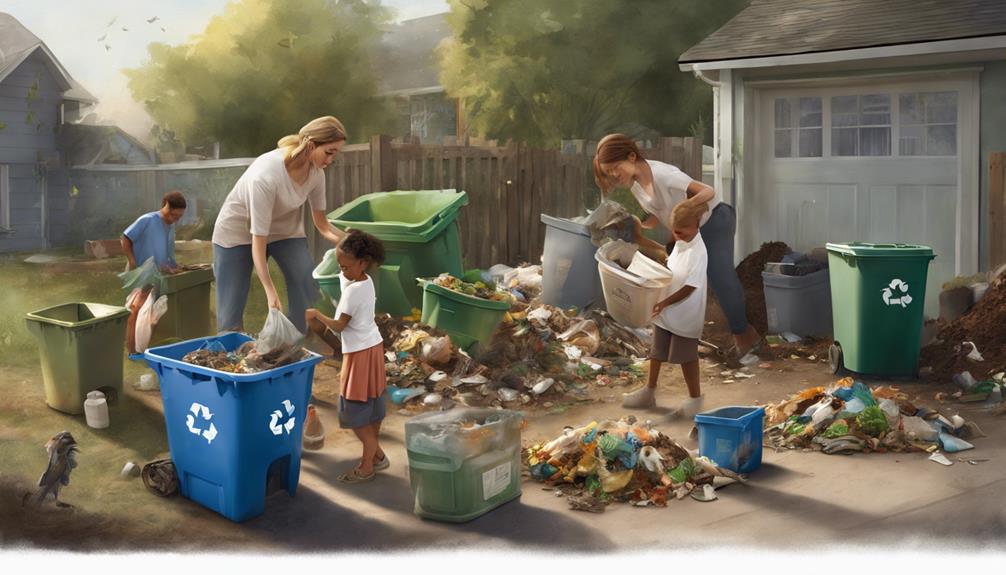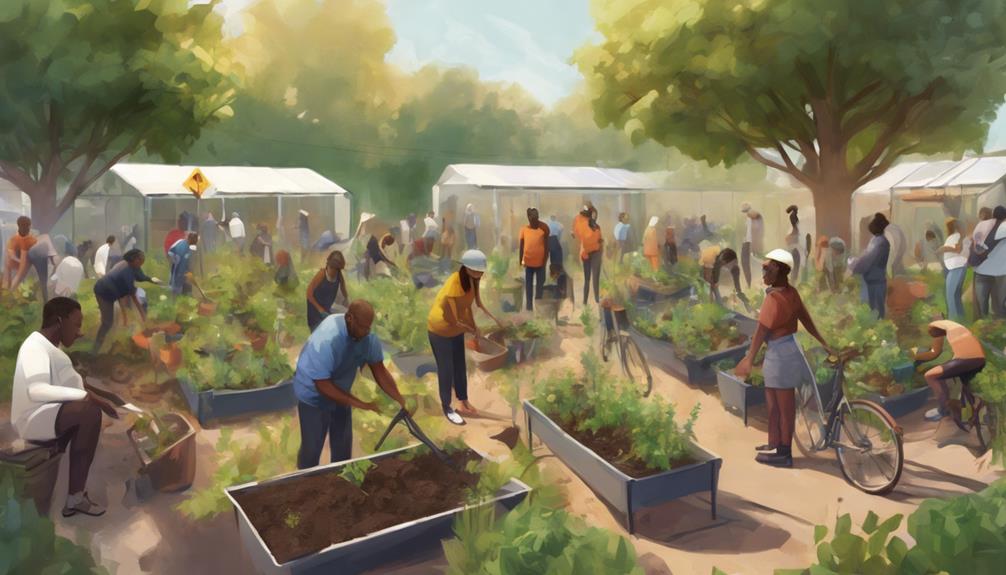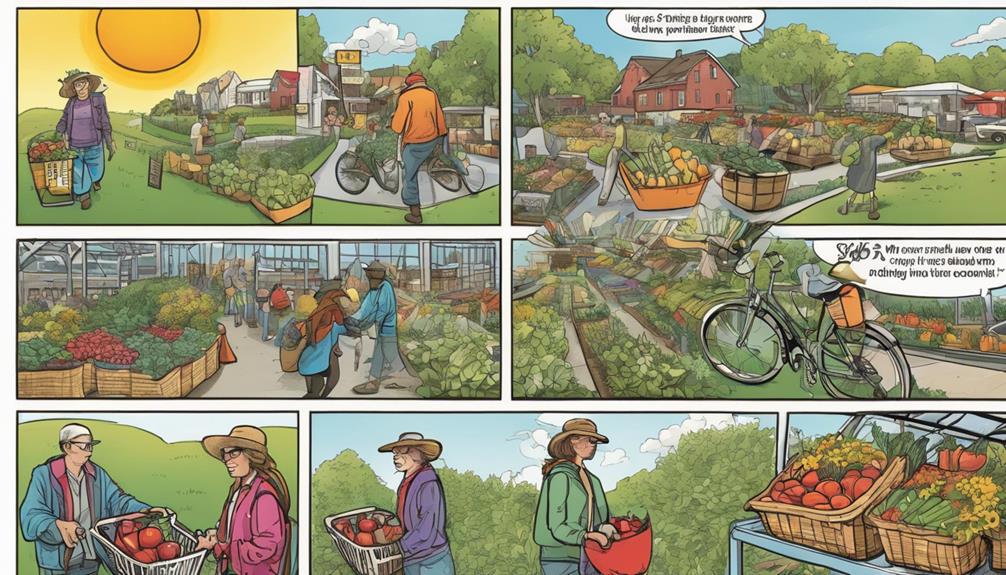Switch to LED bulbs for 80-90% energy efficiency. Upgrade to eco-friendly appliances to cut waste and save energy. Service your boiler regularly for safety. Consider double or triple-glazed windows for better insulation. Proper insulation is key to an eco-friendly home. Seal gaps and draught-proof your space for efficiency. Implement green household practices to lower emissions and utility costs. Opt for public transport, keep tires inflated, or carpool to reduce emissions. Reduce waste by incorporating upcycling and recycling. Choose reusable items over disposables. Embrace sustainable habits for a healthier planet. Save money and the environment with these tips. Implementing sustainable living tips can not only benefit the environment but also save you money in the long run. Conserving water by fixing leaky faucets and taking shorter showers, using energy-efficient lighting and appliances, and reducing your overall consumption can all contribute to a more sustainable lifestyle. Additionally, supporting local and organic food sources, composting kitchen waste, and reducing single-use plastics are all important sustainable living tips to consider for a greener future.
Key Takeaways
- Upgrade to LED lighting for energy efficiency and cost savings.
- Opt for energy-efficient appliances to reduce electricity bills.
- Seal gaps and insulate for better energy conservation.
- Use public transport or carpool to save on fuel costs.
- Embrace sustainable eating habits to lower food expenses.
Energy Efficiency Practices

To improve your household's energy efficiency, consider implementing the following practices.
Start by replacing traditional lighting with LED bulbs, which operate at an impressive 80-90% energy efficiency.
Upgrading to energy-efficient appliances is another impactful step towards reducing waste and energy consumption in your home.
Regularly servicing your boiler not only enhances safety but also boosts its effectiveness, contributing to overall energy savings.
Proper insulation is key to maintaining an eco-friendly home. Consider upgrading to double or triple-glazed windows to improve insulation and reduce heat loss.
Transportation Sustainability Tips

When it comes to transportation sustainability, there are key points to bear in mind for greener commuting and eco-friendly travel choices.
By opting for public transport, you can greatly reduce your carbon footprint and emissions.
Keeping your tires properly inflated not only saves you money but also aids in enhancing fuel efficiency.
Green Commuting Options
Consider incorporating green commuting options into your daily routine to reduce your carbon footprint and contribute to a more sustainable environment.
Utilizing public transportation, carpooling, biking to work, or even walking instead of driving are all eco-friendly transportation choices that can help you save money on transportation while reducing air pollution.
Public transportation alone can substantially cut down carbon dioxide emissions by up to 37 million metric tons annually in the U.S.
Carpooling just twice a week can save around 1,600 pounds of greenhouse gas emissions per year, benefiting both your wallet and the environment.
Biking to work not only can save you an average of $825 per year on transportation costs but also aids in reducing air pollution.
Opting for electric vehicles is another excellent way to embrace green commuting, as it not only lowers fuel costs but also minimizes your environmental impact.
Sustainable Travel Choices
Embrace sustainable travel choices to reduce your carbon footprint and support a more eco-friendly way of exploring the world. Utilizing public transportation is a vital step towards reducing greenhouse gas emissions, with the potential to eliminate up to 37 million metric tons annually.
Carpooling, even just one day a week, can make a remarkable impact by saving over 1,590 pounds of CO2 emissions per year. Opting for biking or walking for short trips not only helps in reducing pollution but also promotes physical health.
When air travel is necessary, consider offsetting flight emissions through carbon credits to mitigate the environmental impact. Choosing eco-friendly transportation options, such as electric vehicles or hybrid cars, can significantly decrease your carbon footprint and contribute to a more sustainable future.
Waste Reduction Strategies

To decrease waste effectively, implementing upcycling and repurposing techniques can greatly minimize the amount of trash ending up in landfills. By finding creative ways to give old items new life, you can significantly reduce the need for single-use products and prevent them from becoming waste.
Additionally, composting food waste in a compost bin can divert a substantial portion of organic waste from ending up in landfills, where it emits harmful greenhouse gases. This simple practice not only reduces emissions but also enriches the soil, supporting healthier plant growth.
Choosing reusable products over single-use items is another impactful way to cut down on waste. From shopping bags to water bottles, opting for reusable alternatives can greatly reduce the amount of trash generated daily.
Furthermore, incorporating sustainable cleaning and beauty products into your routine can help minimize the release of harmful chemicals into the environment. By making these waste reduction strategies a part of your daily life, you can contribute to a healthier planet while also saving money in the long run.
Green Household Practices

Implementing energy-efficient practices in your household can greatly reduce emissions and save you money on utility bills. To reduce your carbon footprint and save money over time, consider the following green household practices:
- Upgrade to Energy-Efficient Appliances:
Swapping out old appliances for energy-efficient models can lead to significant savings on your utility bills. Not only will you reduce your energy consumption, but you'll also lower your home's greenhouse gas emissions.
- Invest in Sustainable Home Insulation:
Making home improvements like installing double-glazed windows and proper insulation can decrease your energy use and reduce its carbon impact. This can result in substantial savings on heating and cooling costs.
- Seal Gaps and Draught-Proof Your Home:
Climate Change Awareness Initiatives

Share climate change facts on your social media platforms to increase awareness within your circle.
Use carbon footprint calculators to understand your impact and make more eco-conscious choices.
Engage in sustainable practices to help combat climate change and advocate for environmental preservation.
Carbon Footprint Awareness
Understanding the impact of your carbon footprint is a significant step towards promoting climate change awareness and sustainable living. By engaging in sustainable practices and conservation efforts, you contribute to a greener future for all.
Here are three actionable steps to increase your carbon footprint awareness:
- Calculate Your Carbon Footprint: Utilize online carbon footprint calculators to assess your personal impact on the environment. This tool provides valuable insights into areas where you can make changes to reduce emissions.
- Share on Social Media: Spread awareness about carbon footprint and climate change by sharing information on your social platforms. Encourage others to join the movement towards sustainable choices and practices.
- Opt for Sustainability: Make sustainable choices in your daily life to minimize your carbon footprint. By choosing eco-friendly products and supporting green initiatives, you actively promote sustainable living and contribute to a healthier planet.
Climate Change Education
Learning about the impacts of climate change through educational initiatives is essential for fostering awareness and action towards a sustainable future. By understanding climate change facts like the increase in greenhouse gas emissions, the rise in global temperatures, and the loss of biodiversity, you can grasp the urgency of the situation.
Take steps to reduce your carbon footprint by calculating and minimizing your emissions. Advocate for sustainable practices and conservation efforts to combat climate change and contribute to environmental protection.
Share information about climate change education to inspire others to join the movement towards a greener future. Support initiatives that promote awareness and encourage individuals to make a positive impact.
Together, we can work towards a more sustainable world by learning, sharing knowledge, and taking action to address the challenges posed by climate change.
Environmental Impact Advocacy
To take action on climate change and advocate for environmental impact awareness, focus on spreading information about reducing emissions and supporting sustainable initiatives.
Share facts like how 20% of U.S. emissions come from households and that 50% of plastics are used for single-use purposes. By advocating for reducing our carbon footprint and supporting eco-friendly choices, you can make a significant difference.
Engage in conservation efforts to protect biodiversity and minimize harmful environmental impacts. Consider offsetting travel emissions through sustainable initiatives to further contribute positively to the environment.
When making choices like selecting reef-safe sunscreen, you not only protect your skin but also safeguard coral reefs and reduce environmental damage. By spreading climate change awareness and actively participating in environmental impact advocacy, you play a pivotal role in creating a more sustainable future for our planet.
Waste Reduction and Recycling Methods

Consider implementing upcycling techniques and recycling methods to reduce waste in your daily life. Start by researching local recycling guidelines and embrace upcycling products to combat the overwhelming amount of single-use plastics, with 50% produced for one-time use annually.
Additionally, reduce food waste – 30-40% of U.S. food is wasted yearly – by composting and being mindful of your shopping habits. Opt for sustainable cleaning and beauty products to avoid harmful chemicals, either by choosing eco-friendly alternatives or making your own.
When it comes to bathroom products, select package-free options like bar soap, bamboo toothbrushes, and paper-wrapped toilet paper to minimize plastic waste. By incorporating these practices into your routine, you can substantially contribute to waste reduction, promote environmental sustainability, and save money in the process.
Sustainable Eating Habits

To make a positive impact on the environment and promote a more sustainable lifestyle, embracing sustainable eating habits is key in reducing your carbon footprint and supporting a healthier food system.
Here are three ways you can adopt sustainable eating habits:
- Consider a Vegetarian or Vegan Diet: By choosing plant-based options, you can notably decrease your carbon footprint and lower greenhouse gas emissions, contributing to a more eco-friendly food system.
- Opt for Locally Sourced Food: Supporting locally sourced food not only promotes sustainable agriculture practices but also diminishes the carbon emissions associated with transportation, helping to build a more sustainable food system.
- Reduce Food Waste through Food Management: Practicing food management techniques like composting and being mindful of food waste can help minimize the 30-40% of U.S. food wasted annually, contributing to a more sustainable and efficient food system that benefits both the environment and your health.
Energy Conservation Techniques

Implementing energy conservation techniques in your daily routine can lead to significant savings and reduce your environmental impact. Simple actions like turning off lights and unplugging electronics when not in use can save you up to 10% on energy bills. Weatherizing your home can reduce energy consumption by 25% and save up to $600 annually. Opting to wash clothes in cold water instead of hot water can save around $60 per year on energy costs. Additionally, air drying clothes instead of using a dryer can save you up to $200 annually in electricity expenses. Conducting a DIY Energy Audit can help identify areas where energy is being wasted, allowing you to make necessary adjustments and save money on utility bills.
| Energy Conservation Ideas | Benefits | Savings |
|---|---|---|
| DIY Energy Audit | Identify energy wastage | Save on utility bills |
| Weatherizing | Reduce energy consumption | Save up to $600/year |
| Air drying clothes | Less electricity consumption | Save up to $200/year |
| Cold water washing | Lower energy costs | Save around $60/year |
| Unplugging electronics | Reduce standby power consumption | Save up to 10% |
Frequently Asked Questions
How Does Sustainability Save Money?
Sustainability saves you money by reducing utility bills through energy efficiency, cutting car-related expenses with eco-friendly transportation choices, lowering grocery costs by minimizing food waste, using homemade cleaning products to save on supplies, and opting for durable items over disposables for long-term savings.
What Are 3 Examples of Living Sustainably or Being Sustainable?
You may wonder how living sustainably impacts you. Consider these practices: recycling glass bottles, walking or biking instead of driving, and planting trees. These simple steps reduce carbon footprint, save money, and benefit the environment.
How Can We Save Money and Save the Environment?
To save money and the environment, try simple changes. Use LED lights to cut energy costs, opt for public transport to save on commuting, wash clothes in cold water for savings, eat plant-based for budget and eco benefits, and shop locally to support sustainability.
What Are 3 Ways You Can Start Living a More Sustainable Life?
To start living more sustainably, you can make a big impact by reducing meat consumption, using public transportation, and shopping locally and seasonally. These simple changes can help save the environment and your wallet!
Conclusion
To sum up, by implementing these sustainable living tips, you can:
- Reduce your carbon footprint
- Save money
- Contribute to a healthier planet
Remember, every little bit helps, so take the leap and make a difference today.
After all, Rome wasn't built in a day, but small changes can lead to big impacts over time.
So, go forth and embrace a greener lifestyle for a brighter tomorrow!









